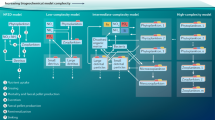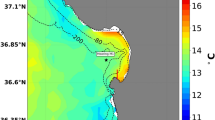Abstract
The history of modeling biological processes associated with marine plankton populations is relatively short, having its origins in the mid-1930s to mid-1940s (see Mills 1989 for an overview). The first models were developed to explain and quantify the processes that resulted in seasonal plankton cycles (e.g., Riley 1946). More recent models have retained the basic structure of the early models, but have extended their realism by incorporating advances in measurements and understanding of biological oceanographic processes.
Access this chapter
Tax calculation will be finalised at checkout
Purchases are for personal use only
Preview
Unable to display preview. Download preview PDF.
Similar content being viewed by others
References
Atkinson, L. P., D. W. Menzel, and K. A. Bush (eds.). 1985. Oceanography of the Southeastern U. S. Continental Shelf, Estuarine and Coastal Sciences 2, American Geophysical Union, 156 pp.
Blanton, J. O., 1972. Exchange of Gulf Stream water with North Carolina shelf water in Onslow Bay during stratified conditions. Res. 18:167–178.
Bryan, K., and J. L. Sarmiento. 1985. Modeling ocean circulation. In: S. Manabe (ed.). Issues in Atmospheric and Oceanic Modeling, Part A, Climate Dynamics. Advances in Geophysics. Vol. 28, Academic Press, 433–459.
Bretherton, F. D., R. E. Davis, and C. D. Fandry. 1976. A technique for objective analysis and design oceanographic experiments applied to MODE-73. Deep-Sea Res. 23:559–582.
Bucklin, A., M. M. Rienecker, and C. N. K. Mooers. 1989. Genetic tracers of zooplankton transport in coastal filaments off northern California. J. Geophys. Res. 94:8277–8288.
Church, J. A., and A. M. G. Forbes. 1981. Non-linear model of tides in the Gulf of Carpentaria. Aust. J. Mar. Freshwater Res., 32:685–698.
Ekman, V. W. 1906. On the influence of the earth’s rotation on ocean currents. Arkiv. f Matematik Astronomi. Fysik, Bd 2, No, 11.
Haidvogel, D. B., and A. R. Robinson (eds.). 1989. Data Assimilation, Dynamics of Atmospheres and Oceans. Vol. 13, nos. 3–4, 518 pp.
Haidvogel, D. B., A. Beckmann, and K. S. Hedstrom. 1991a. Dynamical simulations of filament formation and evolution in the Coastal Transition Zone. J. Geophys. Res. 96:15,017–15,040.
Haidvogel, D. B., J. L. Wilkin, and R. Young. 1991b. A semi-spectral primitive equation circulation model using vertical sigma and orthogonal curvilinear horizontal coordinates. J. Comp. Phys. 94:151–185.
Hedstrom, K. S. 1990. User’s manual for a semi-spectral primitive equation regional ocean-circulation model. Version 3.0, Institute for Naval Oceanography Technical Note FY90–2, 90 pp.
Hofmann, E. E. 1988. Plankton dynamics on the outer southeastern U. S. continental shelf. Part HI: A coupled physical-biological model. J. Mar. Res, 46:919–946.
Hofmann, E. E., and J. W. Ambler. 1988. Plankton dynamics on the outer southeastern U. S. contintal shelf. Part II: A time-dependent biological model. J. Mar. Res. 46:883–917.
Hofmann, E. E., K. S. Hedstr, J. R. Moisan, D. B. Haidvogel, and D. L. Mackas. 1991. The use of simulated drifter tracks to investigate general transport patterns and residence times in the Coastal Transition Zone. J. Geophys. Res. 96:15,041–15,052.
Holland, W. R. 1985. Simulation of mesoscale ocean variability in mid-latitude gyres. In: S. Manabe (ed.). Issues in Atmospheric and Oceanic Modeling, Part A, Climate Dynamics. Advances in Geophysics, Vol. 28, Academic Press, 479–523.
Ishizaka, J. 1990a. Coupling of Coastal Zone Color Scanner data to a physical-biological model of the southeastern U. S. continental shelf ecosystem 1. CZCS data description and Lagrangian particle tracing experiments. J. Geophys. Res. 95:20,167–20,181.
Ishizaka, J. 1990b. Coupling of Coastal Zone Color Scanner data to a physical-biological model of the southeastern U. S. continental shelf ecosystem 2. An Eulerian Model. J. Geophys. Res. 95: 20,183–20,199.
Ishizaka, J. 1990c. Coupling of Coastal Zone Color Scanner data to a physical-biological model of the southeastern U. S. continental shelf ecosystem 3. Nutrient and phytoplankton fluxes and CZCS data assimilation. J. Geophys. Res. 95:20,201–20,212.
Ishizaka, J., and E. E. Hofmann. 1988. Plankton dynamics on the outer southeastern U. S. continental shelf. Part I: Lagrangian particle tracing experiments. J. Mar. Res. 46:853–882.
Lee, T. N., L. P. Atkinson, and R. Legeckis. 1981. Observations of a Gulf Stream frontal eddy on the Georgia continental shelf, April 1977. Deep-Sea Res. 28:347–378.
Lewis, M. R., J. J. Cullen, and T. Piatt. 1983. Phytoplankton and thermal structure in the upper ocean: Consequences of nonuniformity in chlorophyll profile. J. Geophys. Res. 88:2365–2570.
Mackas, D. L., L. Washburn, and S. L. Smith. 1991. Zooplankton community pattern associated with a California Current cold filament. J. Geophys. Res. 96:14,781–14,797.
Malone, T. C. 1975. Environmental control of phytoplankton cell size. Limnol. Oceanogr. 20:490.
McClain, C. R., J. Ishizaka, and E. E. Hofmann. 1990. Estimation of the processes controlling variability in phytoplankton pigment distributions on the southeastern U. S. continental shelf. J. Geophys. Res. 95:20,213–20,235.
Mills, E.L. 1989. Biological Oceanography: An Early History. 1870–1960. Cornell University Press, Ithaca and London, 378 pp.
Peterson, W. T., C. B. Miller, and A. Hutchinson. 1979. Zonation and maintenance of copepod populations in the Oregon upwelling zone. Deep-Sea Res. 26:467–494.
Riley, G. A. 1946. Factors controlling phytoplankton populations on Georges Bank. J. Mar. Res. 6:54–73.
Rothlisberg, P. C. 1982. Vertical migration and its effect on dispersal of penaeid shrimp larvae in the Gulf of Carpentaria, Australia. U. S. Fish. Bull. 80:541–554.
Rothlisberg, P. C., J. A. Church, and A. M. G. Forbes. 1983. Modelling the advection of vertically migrating shrimp larvae. J. Mar. Res. 41:511–538.
Semtner, A. J., Jr. 1974. An oceanic general circulation model with bottom topography. Numerical Simulation of Weather and Climate, Technical Report No. 9, Department of Meteorology, University of California, Los Angeles.
Semtner, A. J., Jr. 1986. Finite-difference formulation of a World Ocean model. In: J. J. O’Brien (ed.). Advanced Physical Oceanography Numerical Modelling. D. Riedel Publishing Company, Philadelphia, pp. 187–202.
Smith, W. O., G. W. Hebum, R. T. Barber, and J. J. O’Brien. 1983. Regulation of phytoplankton communities by physical processes in upwelling ecosystems. J. Mar. Res. 4,41:539–556.
Staples, D. J. 1979. Seasonal migration patterns of postlarval and juvenile banana prawns, Penaeus merguiensis de Man, in the major rivers of the Gulf of Carpentaria, Australia. Aust. J. Mar. Freshwater Res. 30: 143–157.
Thompson, J. D. 1974. The coastal upwelling cycle on a beta plane: Hydrodynamics and thermodynamics. Ph.D. Dissertation, Florida State University, 141 pp.
Walsh, J. J. 1972. Implications of a systems approach to oceanography. Science 176:969–975.
Walsh, J. J. 1975. A spatial simulation model of the Peru upwelling ecosystem. Deep-Sea Res, 22:201–236.
Walsh, J. J., D. A. Dieterle, and M. B. Meyers. 1988. A simulation analysis of the fate of phytoplankton within the Mid-Atlantic Bight. Com. Shelf Res, 8:757–787.
Wroblewski, J. S. 1977. A model of phytoplankton plume formation during variable Oregon upwelling. J. Mar. Res. 35:357–393.
Wroblewski, J. S. 1982. Interaction of currents and vertical migration in maintaining Calanus marshallae in the Oregon upwelling zone—a simulation. Deep-Sea Res, 29:665–686.
Wroblewski, J. S., and E. E. Hofmann. 1989. U. S. interdisciplinary modeling studies of coastal-offshore exchange processes: Past and future. Prog, Oceanog, 23:65–99.
Editor information
Editors and Affiliations
Rights and permissions
Copyright information
© 1993 Springer-Verlag Berlin Heidelberg
About this paper
Cite this paper
Hofmann, E.E. (1993). Coupling of Circulation and Marine Ecosystem Models. In: Levin, S.A., Powell, T.M., Steele, J.W. (eds) Patch Dynamics. Lecture Notes in Biomathematics, vol 96. Springer, Berlin, Heidelberg. https://doi.org/10.1007/978-3-642-50155-5_11
Download citation
DOI: https://doi.org/10.1007/978-3-642-50155-5_11
Publisher Name: Springer, Berlin, Heidelberg
Print ISBN: 978-3-540-56525-3
Online ISBN: 978-3-642-50155-5
eBook Packages: Springer Book Archive




